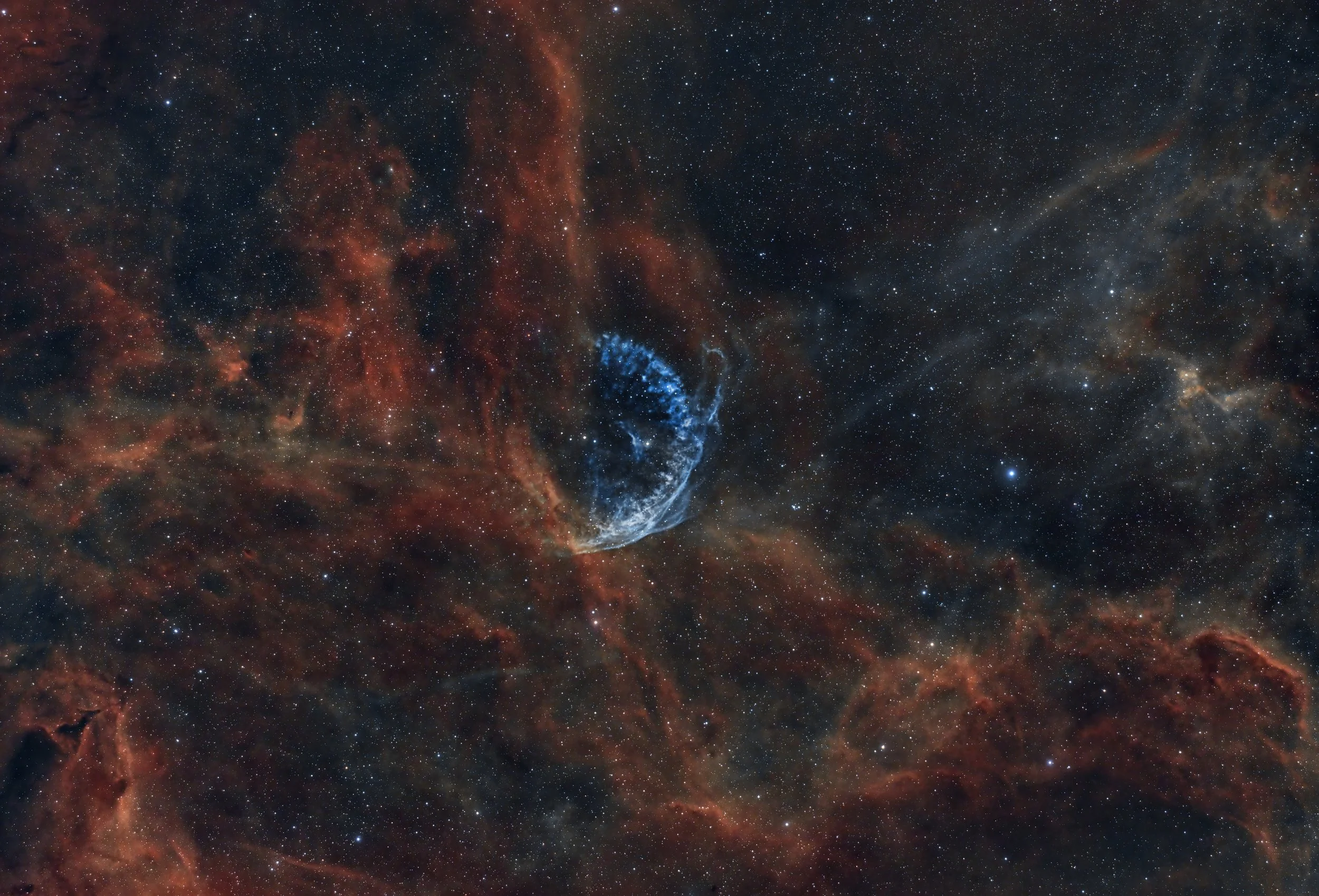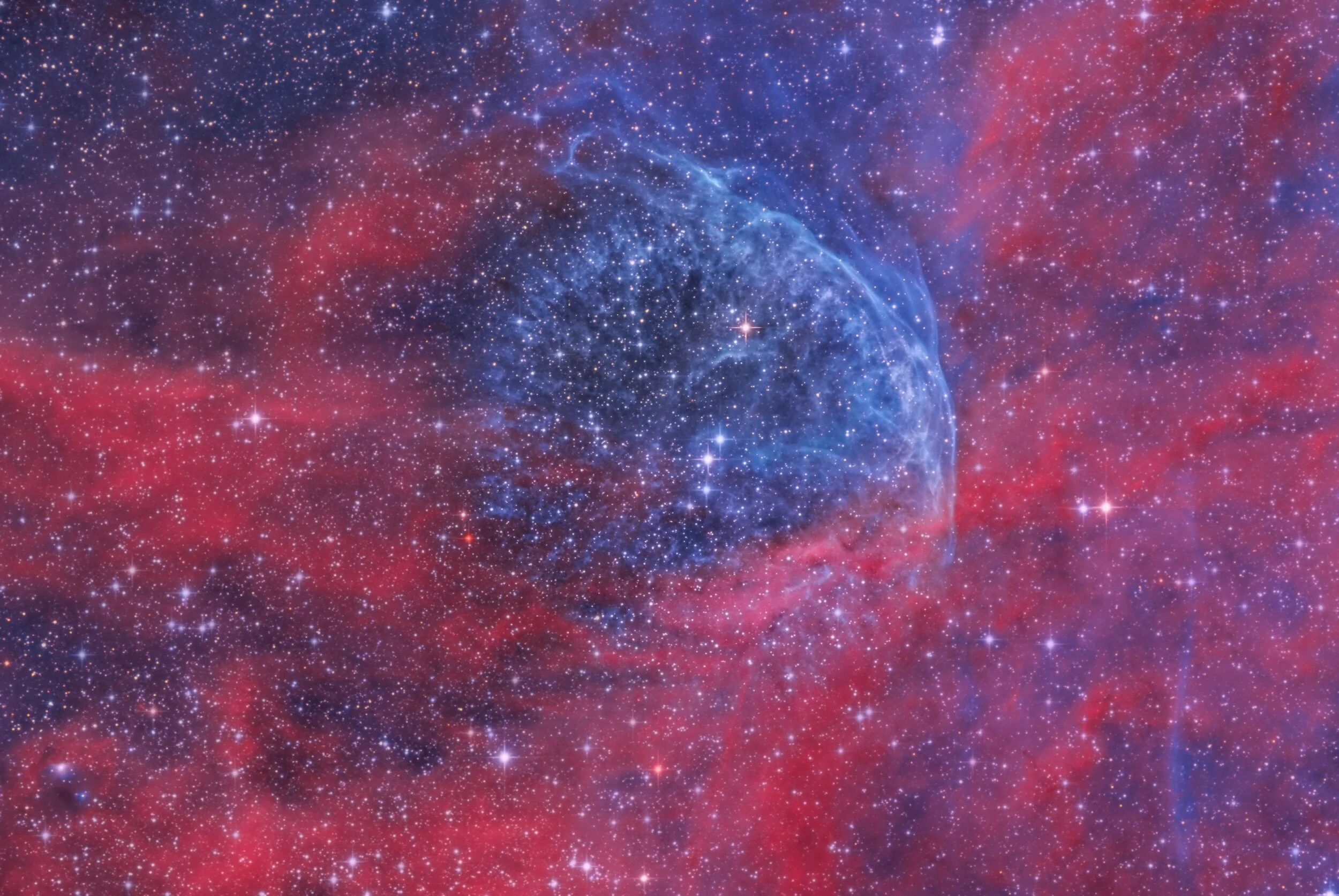
AAPOD2 Image Archives
WR 134 region
In the constellation Cygnus, the brilliant Wolf-Rayet star WR 134 casts its influence across the cosmos, sculpting a stunning bubble of ionized gas that glows like a delicate cosmic wreath. This celestial feature is a powerful testament to the dynamic life cycles of massive stars.
The nebula’s faint yet intricate arcs, shaped by intense stellar winds, symbolize the beauty of transformation and renewal—an ideal image to ring in the new year. WR 134 serves as a reminder that even the most tumultuous forces can create breathtaking works of art in the universe, echoing themes of resilience and the promise of fresh beginnings.
As the new year dawns, this cosmic masterpiece invites us to marvel at the wonders of change and embrace the possibilities that lie ahead, just as the stars shape and reshape the cosmos around them.
WR 134
WR 134, a captivating member of the Wolf-Rayet star family, stands as a beacon of stellar grandeur in the cosmos. This massive and luminous star has shed its outer layers, creating a stellar wind that rushes into space, sculpting intricate patterns in the surrounding interstellar medium. Its fierce radiance and powerful emissions reveal the profound evolutionary processes occurring within its core.
WR 134
WR 134 resides in the Cygnus constellation as a nitrogen-rich Wolf-Rayet star, belonging to a binary system. These massive stars are characterized by strong stellar winds that strip away their hydrogen envelopes, exposing their dense cores. WR 134's potent winds influence its binary companion and contribute to the galaxy's heavy element enrichment. As short-lived cosmic entities, Wolf-Rayet stars like WR 134 play a pivotal role in the stellar lifecycle, shaping interstellar environments and aiding in the creation of subsequent star generations.
WR-134
WR 134 is a Wolf-Rayet star in Cygnus which is around 6,000 light years distant. It shines at 400,000 times the luminosity of the sun. Intense radiation and stellar winds have created a bubble of gas around the star. In this image the bubble is seen in blue/green doubly ionized oxygen (OIII) light. A large amount of hydrogen (HII) emission is also displayed as the red areas. The star responsible for this is near the center of the bubble and is whiteish. The image was taken with my #Stellarvue SVX 152T refractor and #zwoasi 6200 camera through RGB and HII/OIII filters. The image combines a bit over 47 hours of exposure time. Automation was controlled with a #primalucelab Eagle 4 pro and Voyager Astrophotography Automation software. The image is cropped and rotated for a pleasing view.
COPYRIGHT: Jon Talbot
WOLF RAYET 134
WR 134 is a variable Wolf-Rayet star located around 6,000 light years away from Earth in the constellation of Cygnus, surrounded by a faint bubble nebula blown by the intense radiation and fast wind from the star. It is five times the radius of the sun, but due to a temperature over 63,000 K it is 400,000 times as luminous as the Sun.
photo taken from my backyard in Carpentras (Vaucluse) France
Telescop : 10" f/4 TS ONTC Newton
Camera : ZWO ASI 294MM
Mount: iOptron CEM70
Camera autoguiding : ZWO ASI290MM Mini
Explore scientific HR COMA CORRECTOR
Logiciels: Photoshop · Nighttime Imaging ‘N’ Astronomy · PHD2 Guiding · Pixinsight 1.8
Filtres: Antlia 3.5nm OIII 36mm & 3.0nm Ha 36mm
Chroma RGB 36mm
Accessoire: PrimaLuce Sesto Senso 2
Dates:6 juillet 2021 , 7 juillet 2021 , 8 juillet 2021 , 9 juillet 2021 , 14 juillet 2021 , 18 juillet 2021 , 19 juillet 2021 , 20 juillet 2021
Images unitaires:
Antlia 3.0nm Ha 36mm: 155x240" (10h 20') (gain: 120.00) -10C bin 2x2
Antlia 3.0nm Ha 36mm: 49x360" (4h 54') (gain: 120.00) -10C bin 2x2
Antlia 3.5nm OIII 36mm: 72x180" (3h 36') (gain: 120.00) -10C bin 2x2
Antlia 3.5nm OIII 36mm: 120x240" (8h) (gain: 120.00) -10C bin 2x2
Antlia 3.5nm OIII 36mm: 43x360" (4h 18') (gain: 120.00) -10C bin 2x2
Chroma LRVB 36mm: 90x120" (3h) (gain: 120.00) -10C bin 2x2
Intégration: 34h 8'
Darks: ~64
Flats/PLU: ~7
Dark-flats: ~30
Âge de la Lune (moyen): 17.98 jours
Phase de la Lune (moyenne): 32.23%
Echelle d'obscurité de Bortle: 6.00
Centre AD: 20h 10' 22"
Centre DEC: +36° 11' 3"
Échantillonnage: 0,907 arcsec/pixel
Orientation: 1,422 degrés
Rayon du champ: 0,593 degrés
Copyright: Anthony Husson
WR 134 Nebula
Image Description and Details :
WR 134 is a variable Wolf-Rayet star located around 6,000 light years away from Earth in the constellation of Cygnus, surrounded by a faint bubble nebula blown by the intense radiation and fast wind from the star. The bubble nebula is essentially visible in OIII. Image made in HOO mixing + RGB for the star colors. TSA102 - AZEQ6 - CCD Atik 16200Filters Baader ultranarrowband Ha 3,5nm & OIII 4,5nmGuiding : OAG + Atik GPHa : 68 x 900s bin1 OIII : 20 x 900s bin1 + 58 x 600s bin2 RGB : 36 x 300sTotal integration : 35h Processing : Pixinsight, Starnet++, Photoshop 2020
Copyright Information: Copyright : Jean-Baptiste Auroux







